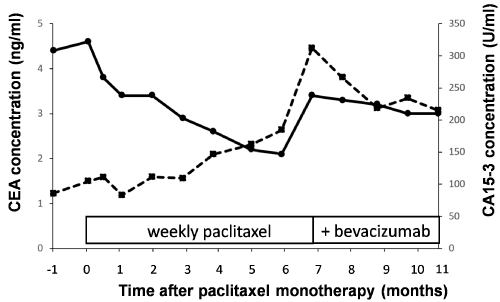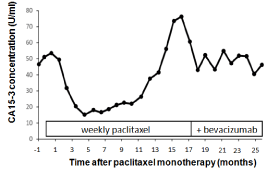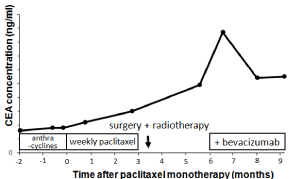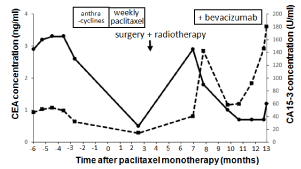Case Series
Therapeutic Option of Adding Bevacizumab to Paclitaxel after Treatment Failure for Patients with Metastatic Breast Cancer: Case Reports and Literature Review
Kazuhiko Sato1*, Hiromi Fuchikami1, Naoko Takeda1 and Masaru Iwai2
1Department of Breast Oncology, Tokyo-West Tokushukai Hospital, Japan
2Department of Pharmacy, Tokyo-West Tokushukai Hospital, Japan
*Corresponding author: Kazuhiko Sato, Department of Breast Oncology, Tokyo-West Tokushukai Hospital, 3-1-1 Matsubara, Akishima, Tokyo 196-0003, Japan
Published: 13 Feb, 2017
Cite this article as: Sato K, Fuchikami H, Takeda N, Iwai
M. Therapeutic Option of Adding
Bevacizumab to Paclitaxel after
Treatment Failure for Patients with
Metastatic Breast Cancer: Case
Reports and Literature Review. Clin
Surg. 2017; 2: 1306.
Abstract
Introduction: Adding bevacizumab can change an impaired blood supply after resistance to weekly
paclitaxel for metastatic breast cancer (MBC). We experienced effective tumor management by
adding bevacizumab to paclitaxel refractory disease.
Case 1: A 70-year-old female had multiple lymph-node metastases. After seven months of paclitaxel,
she received bevacizumab additional to paclitaxel due to disease progression. Tumor markers were
gradually reduced over five months.
Case 2: A 50-year-old female developed lymph-node metastases and multiple bone metastases were
also revealed later. After 16 months of paclitaxel, tumor markers were gradually reduced over the
next 12 months by also using bevacizumab.
Case 3: A 45-year-old woman had received neoadjuvant chemotherapy using anthracyclines and
weekly paclitaxel. During post mastectomy radiation therapy, left chest wall recurrence, lung
metastases, and liver metastases were found. Although the interval between paclitaxel monotherapy
and paclitaxel plus bevacizumab was only three months, tumor markers were reduced over four
months.
Case 4: A 42-year-old woman had been referred due to left inflammatory breast cancer; she had
been using anthracyclines and weekly paclitaxel. Left chest wall recurrence and lymph node
metastases were found after neoadjuvant chemotherapy. Although the interval between paclitaxel
monotherapy and paclitaxel plus bevacizumab was only five months, tumor markers were reduced
over the next five months.
Discussion: It was difficult to draw any conclusions regarding the efficacy of adding bevacizumab
from this retrospective case series. However, the strategy of additional bevacizumab should be
considered and may change the clinical practice for patients with MBC.
Keywords: Metastatic breast cancer; Paclitaxel; Bevacizumab; Resistance; Quality of life
Introduction
Because of an increase in the number of early-stage breast cancer cases, recent advances in
systemic treatments have also increased and the death rate in the United States has dropped by
34% since 1990 [1]. However, continuous efforts are needed to control this disease, since remaining
cancer cells after an initial treatment leads to metastatic breast cancer (MBC). There has been a
variety of new agents developed for patients with MBC, but the disease is still difficult to cure. The
treatment aims for these patients are to prolong the survival period, reduce the disease burden,
and maintain a good quality of life (QOL). Less toxic agents are preferred to maintain QOL, but
chemotherapeutic agents should be considered for every patient with estrogen-receptor negative,
hormonal treatment refractory, or rapidly progressive visceral diseases.
In terms of chemotherapy for MBC, anthracycline containing regimens and taxanes are
recognized as key drugs in a first-line setting. To improve the survival benefit and satisfactory response
rate by these regimens, combination treatments using another chemotherapeutic or biological
agent have been investigated. In patients with human epidermal growth factor receptor 2 (HER2)-negative MBC, combination chemotherapies such as paclitaxel
plus gemcitabine [2] and capecitabine plus docetaxel [3] have been
reported to improve overall survival (OS). However, although
combination chemotherapies are more effective than when the same
agents are administered sequentially, they are usually associated
with increased toxicity such as a significant detrimental effect on
white cell counts, increased alopecia, and nausea and vomiting [4].
Therefore, whether combination regimens are more effective than
single agents when given sequentially is unclear in terms of QOL,
suggesting that a sequential monotherapy should be used unless there
is rapid disease progression [4]. Bevacizumab (Genentech, South San
Francisco, CA) is a recombinant humanized monoclonal antibody
to all vascular endothelial growth factor (VEGF-A) isoforms. An
initial therapy of paclitaxel plus bevacizumab for MBC has been
reported to prolong progression-free survival (PFS) and increase the
objective response rate with minimal toxicities [5]. Bevacizumab plus
other chemotherapy drugs has also been proved to improve PFS in a
first-line setting for patients with MBC by AVADO and RIBBON–1
trials [6,7] and in a second-line setting by the BIBBON−2 trial [8].
However, the indication of bevacizumab for patients with MBC was
approved with a concomitant use of paclitaxel only in Japan. In a
clinical practice, there may not be many patients who benefit from
paclitaxel plus bevacizumab in terms of a high response rate to reduce
a large tumor burden in early-line chemotherapy, and prolonging the
PFS was a most important benefit of paclitaxel with bevacizumab, as
proved by several clinical trials. Although the addition of bevacizumab
to paclitaxel achieved no significant adverse effects on health-related
QOL compared with paclitaxel alone [9], it is still unclear whether
the addition of bevacizumab with its expensive medical cost and
potential side effects has an OS benefit [10]. Given that a paclitaxel
monotherapy is usually considered as the first-line setting, another
chemotherapeutic regimen should be introduced after developing
paclitaxel resistance.
Several mechanisms of chemotherapy resistance in solid tumors
have been reported at the cellular level, such as functional gene
mutations or other changes that influence uptake, metabolism, and
export of drugs from cancer cells. The tumor microenvironment
also mediates the resistance of chemotherapy because it is related to
drug distribution to cancer cells through the tumor vasculature [11].
Patients with MBC are usually treated with a single agent paclitaxel
given on a weekly schedule as a front-line therapy, because it appears
to offer better PFS than a tri weekly schedule [12,13] or a ixabepilone
treatment, and less hematologic toxicity was observed than with
nab-paclitaxel [13,14]. Such a low-dose of paclitaxel might cause
limited cell death but it also leads to reductions in tumor density
and interstitial fluid pressure (IFP) that enhances drug distribution
[15]. Therefore, a potential strategy to modify the resistance of
weekly paclitaxel is to change the impaired blood supply to the tumor
because drug activity to the tumor may remain. Adding bevacizumab
to paclitaxel is one therapeutic option to remedy these micro
environmental abnormalities if resistance occurs.
In these case reports, we experienced effective tumor
management with a long-term combination treatment of paclitaxel
plus bevacizumab therapy. Here we introduce examples of typical
cases that may have benefited by adding bevacizumab after paclitaxel
refractory disease.
Figure 1
Figure 1
CEA (―) and CA15-3 (---) serum concentrations during the
course of paclitaxel plus bevacizumab following paclitaxel monotherapy for metastatic breast cancer.
Figure 2
Figure 2
CA15-3 serum concentrations during the course of paclitaxel plus
bevacizumab following paclitaxel monotherapy for metastatic breast cancer.
Figure 3
Figure 3
CEA serum concentrations during the course of paclitaxel plus
bevacizumab for subsequent metastatic disease shortly after paclitaxelcontaining
neoadjuvant chemotherapy in patient with locally advanced breast
cancer.
Case Presentation
Addition of bevacizumab to paclitaxel after treatment failure of weekly paclitaxel as first-line chemotherapy.
Case 1
A 70-year-old female was referred to our hospital for multiple
lymph-node metastases in the right axilla, the right supraclavicular
area, and the right parasternal region. She had a right mastectomy
with axillary dissection followed by the sequence of anthracyclines
and docetaxel in the adjuvant chemotherapy. The pathological
diagnosis was invasive ductal carcinoma, which was positive for
estrogen receptor (ER), negative for progesterone receptor (PgR),
and positive for human EGFR-related protein. After four years
of adjuvant hormonal treatment with anastrozole, lymph node
metastases were revealed. After surgery and radiotherapy to remove
the lesions, letrozole was administered as a re-adjuvant therapy.
For other metastases that were later observed in the liver and
lung, fulvestrant and a mammalian target of rapamycin inhibitors
combined with exemestane was introduced sequentially over five
years. A weekly paclitaxel monotherapy had been chosen as the firstline
chemotherapy. After seven months of paclitaxel treatments,
tumor markers, such as, carcinoembryonic antigen (CEA) and cancer
antigen 15-3 (CA 15-3), were gradually elevated with a concurrent
increase in the size and number of tumors in the liver. The patient
received additional bevacizumab to paclitaxel. Although a dramatic
shrinkage of the tumors was not observed, the tumor markers
gradually reduced over the five month course of treatment (Figure 1).
Paclitaxel plus bevacizumab is still being administered.
Case 2
A 50-year-old female developed lymph-node metastases in the
right supraclavicular and parasternal regions, and multiple bone
metastases were also later revealed in the thoracic and lumbar spine.
She had undergone breast-conserving treatment with sentinel-node
biopsy. The pathological diagnosis was invasive ductal carcinoma,
which was ER positive, PgR positive, and HER2 positive. During
three years of adjuvant hormonal therapy using luteinizing hormonereleasing
hormone (LH-RH) agonists with tamoxifen, lymph-node
metastases were observed. Although trastuzumab was tried, it was
difficult to administer it continuously because of cardiac toxicity.
Hormonal therapy including LH-RH and letrozole, zolendronic
acid, and radiation treatment had been performed over five years to
the bones, parasternal, and brain metastases. Weekly paclitaxel with
zolendronic acid had been chosen as the first-line chemotherapy.
After 16 months of paclitaxel, the tumor marker levels were elevated
with evidence of disease progression by a computed tomography scan.
The patient received additional bevacizumab to paclitaxel. Although
no dramatic shrinkage of the tumor was observed, tumor markers
were gradually reduced over 12 months (Figure 2). Paclitaxel plus
bevacizumab is still being administered. Addition of bevacizumab to
paclitaxel after short-term recurrence (< 6 months) following weekly
paclitaxel as a neoadjuvant chemotherapy.
Case 3
A 45-year-old woman had been referred to our hospital due to a
bulky lump in the left breast. After neoadjuvant chemotherapy using
anthracyclines and weekly paclitaxel, a mastectomy and axillary
dissection was performed. The pathological diagnosis was invasive
ductal carcinoma, which was ER negative, PgR negative, and HER2
negative. During post mastectomy radiation therapy, left chest wall
recurrence, lung metastases, and liver metastases were found. Weekly
paclitaxel plus bevacizumab was administered. Although the interval
between the paclitaxel monotherapy and paclitaxel plus bevacizumab
was only three months, the tumor marker levels were reduced over
four months until she refused further treatment due to various social
reasons (Figure 3).
Case 4
A 42-year-old woman had been referred to our hospital due to left
inflammatory breast cancer. After neoadjuvant chemotherapy using
anthracyclines and weekly paclitaxel, a mastectomy and axillary node
dissection was performed. The pathological diagnosis was invasive
ductal carcinoma, which was ER negative, PgR negative, and HER2 negative. Two months after post mastectomy radiation therapy, left
chest wall recurrence and lymph node metastases in the bilateral
axilla, both in the parasternal regions, the left supraclavicular area,
and the bilateral mediastinum regions were found. Weekly paclitaxel
plus bevacizumab was administered. Although the interval between
paclitaxel monotherapy and paclitaxel plus bevacizumab was only
five months, tumor markers were reduced over the next five months
until disease progression was later confirmed (Figure 4).
Figure 4
Figure 4
CEA (―) and CA15-3 (---) serum concentrations during the
course of paclitaxel plus bevacizumab for subsequent metastatic disease
shortly after paclitaxel-containing neoadjuvant chemotherapy in patient with
inflammatory breast cancer.
Discussion
Although a substantial benefit is expected with an addition
of bevacizumab to standard chemotherapy in terms of OS [10],
no clinical trials have demonstrated an OS advantage. In clinical
practice, a taxane monotherapy such as weekly paclitaxel is frequently
used as a first-line treatment because of the additional medical cost
and potential toxicities such as proteinuria, hypertension, and
cardiovascular events. The mechanism of efficacy with such low-dose
chemotherapy was related to the tumor microenvironment, which
may be different from standard chemotherapy with maximum doses.
In the tissue surrounding the tumor, the IFP is regulated by
vascular permeability, lymphatic drainage, and the microvascular
pressure, and tissue oxygen levels are also regulated by oxygen
consumption, blood flow rate, and hemoglobin saturation in the
blood vessels. In a neoadjuvant setting, weekly paclitaxel decreases
the IFP and increases tissue oxygen levels, while such significant
effects was not observed by a dose-dense doxorubicin containing
regimen. A second-line treatment should be considered after
treatment failure mainly caused by resistance to chemotherapy.
Two mechanisms of drug resistance have been proposed: gene
mutations, gene amplification, or epigenetic changes, which influence
the uptake, metabolism, or export of a drug from cancer cells; and
modification of the tumor microenvironment. The main mechanism
of resistance to weekly paclitaxel may be associated with the tumor
microenvironment, where tumors become hypervascular with the
leaky vessels and the spatially and temporally heterogeneous blood
flow. This leads to increased IFP and focal hypoxia, creating barriers
to delivery and efficacy of therapeutics. Therefore, the addition of
bevacizumab after resistance to weekly paclitaxel has the potential to
be an important further treatment option. The proposed mechanisms
of benefit from a combination of bevacizumab with chemotherapy
include the inhibition of new-vessel formation, killing of immature
tumor vessels, a transient normalization of the remaining vasculature
by decreasing the IFP and hypoxia, and a possible synergic effect that leads to an enhanced direct cytotoxicity in some subsets expressing VEGF receptors [16].
In the E2100 trial, the median PFS after adding bevacizumab to
weekly paclitaxel as a first-line treatment was extended from 5.9 to
11.8 months [4]. In our case series, bevacizumab plus paclitaxel could
be administered for longer than six months (case 1) and 12 months
(case 2) after a six month and 15 months weekly paclitaxel treatment,
respectively. If paclitaxel therapy does not show any intolerable side
effects, then the addition of bevacizumab with paclitaxel is a promising
treatment option. According to a comparison of QOL outcomes
during different chemotherapy lines, QOL shows a progressive
deterioration over the chemotherapy lines [17]. Therefore, although
no dramatic improvement was achieved, a relatively long treatment
period by adding bevacizumab was observed in our case series, which
may be associated with a good QOL.
Conclusion
Since there were no data showing crossover results to bevacizumab after disease progression in the chemotherapy-alone group, it was difficult to draw any conclusions from this retrospective case series regarding the efficacy of adding bevacizumab. Because bevacizumab is only allowed to be used with paclitaxel in Japan, this strategy of additional bevacizumab should be considered and may change clinical practices for patients with MBC.
References
- DeSantis C, Ma J, Bryan L, Jemal A. Breast cancer statistics, 2013. CA Cancer J Clin. 2014; 64: 52-62.
- Albain KS, Nag SM, Calderillo-Ruiz G, Jordaan JP, Llombart AC, Pluzanska A, et al. Gemcitabine plus Paclitaxel versus Paclitaxel monotherapy in patients with metastatic breast cancer and prior anthracycline treatment. J Clin Oncol. 2008; 26: 3950-3957.
- O'Shaughnessy J, Miles D, Vukelja S, Moiseyenko V, Ayoub JP, Cervantes G, et al. Superior survival with capecitabine plus docetaxel combination therapy in anthracycline-pretreated patients with advanced breast cancer: phase III trial results. J Clin Oncol. 2002; 20: 2812-2823.
- Dear RF, McGeechan K, Jenkins MC, Barratt A, Tattersall MH, Wilcken N. Combination versus sequential single agent chemotherapy for metastatic breast cancer. Cochrane Database Syst Rev. 2013; 12: CD008792.
- Miller K, Wang M, Gralow J, Dickler M, Cobleigh M, Perez EA, et al. Paclitaxel plus bevacizumab versus paclitaxel alone for metastatic breast cancer. N Engl J Med. 2007; 357: 2666-2676.
- Miles DW, Chan A, Dirix LY, Cortés J, Pivot X, Tomczak P, et al. Phase III study of bevacizumab plus docetaxel compared with placebo plus docetaxel for the first-line treatment of human epidermal growth factor receptor 2-negative metastatic breast cancer. J Clin Oncol. 2010; 28: 3239-3247.
- Robert NJ, Diéras V, Glaspy J, Brufsky AM, Bondarenko I, Lipatov ON, et al. RIBBON-1: randomized, double-blind, placebo-controlled, phase III trial of chemotherapy with or without bevacizumab for first-line treatment of human epidermal growth factor receptor 2-negative, locally recurrent or metastatic breast cancer. J Clin Oncol. 2011; 29: 1252-1260.
- Brufsky AM, Hurvitz S, Perez E, Swamy R, Valero V, O'Neill V, et al. RIBBON-2: a randomized, double-blind, placebo-controlled, phase III trial evaluating the efficacy and safety of bevacizumab in combination with chemotherapy for second-line treatment of human epidermal growth factor receptor 2-negative metastatic breast cancer. J Clin Oncol. 2011; 29: 4286-4293.
- Croom KF, Dhillon S. Bevacizumab: a review of its use in combination with paclitaxel or capecitabine as first-line therapy for HER2-negative metastatic breast cancer. Drugs. 2011; 71: 2213-2229.
- Delaloge S, Pérol D, Courtinard C, Brain E, Asselain B, Bachelot T, et al. Paclitaxel plus bevacizumab or paclitaxel as first-line treatment for HER2-negative metastatic breast cancer in a multicenter national observational study. Ann Oncol. 2016; 27: 1725-1732.
- Trédan O, Galmarini CM, Patel K, Tannock IF. Drug resistance and the solid tumor microenvironment. J Natl Cancer Inst. 2007; 99: 1441-1454.
- Seidman AD, Berry D, Cirrincione C, Harris L, Muss H, Marcom PK, et al. Randomized phase III trial of weekly compared with every-3-weeks paclitaxel for metastatic breast cancer, with trastuzumab for all HER-2 overexpressors and random assignment to trastuzumab or not in HER-2 nonoverexpressors: final results of Cancer and Leukemia Group B protocol 9840. J Clin Oncol. 2008; 26: 1642-1649.
- Gligorov J, Richard S. Breast cancer: weekly paclitaxel--still preferred first-line taxane for mBC. Nat Rev Clin Oncol. 2015; 12: 508-509.
- Rugo HS, Barry WT, Moreno-Aspitia A, Lyss AP, Cirrincione C, Leung E, et al. Randomized Phase III Trial of Paclitaxel Once Per Week Compared With Nanoparticle Albumin-Bound Nab-Paclitaxel Once Per Week or Ixabepilone With Bevacizumab as First-Line Chemotherapy for Locally Recurrent or Metastatic Breast Cancer: CALGB 40502/NCCTG N063H (Alliance). J Clin Oncol. 2015; 33: 2361-2369.
- Taghian AG, Abi-Raad R, Assaad SI, Casty A, Ancukiewicz M, Yeh E, et al. Paclitaxel decreases the interstitial fluid pressure and improves oxygenation in breast cancers in patients treated with neoadjuvant chemotherapy: clinical implications. J Clin Oncol. 2005; 23: 1951-1961.
- Jain RK, Duda DG, Clark JW, Loeffler JS. Lessons from phase III clinical trials on anti-VEGF therapy for cancer. Nat Clin Pract Oncol. 2006; 3:24-40.
- Zabernigg A, Giesinger JM, Pall G, Gamper EM, Gattringer K, Wintner LM, et al. Quality of life across chemotherapy lines in patients with cancers of the pancreas and biliary tract. BMC Cancer. 2012; 12: 390.




